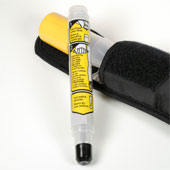
 An allergic reaction in an outdoor setting can rapidly become a life-threatening emergency. While most of us think of food allergies as annoyances, they can be quite serious or even life threatening. Itchy skin rashes can progress to breathing difficulty, swollen soft tissues (e.g., lips, tongue, throat) that compromise the airway, and low blood pressure or even shock. Therefore, ita??s important to be familiar with the signs and symptoms of severe allergy and to be prepared to respond rapidly in the event of an emergency.
An allergic reaction in an outdoor setting can rapidly become a life-threatening emergency. While most of us think of food allergies as annoyances, they can be quite serious or even life threatening. Itchy skin rashes can progress to breathing difficulty, swollen soft tissues (e.g., lips, tongue, throat) that compromise the airway, and low blood pressure or even shock. Therefore, ita??s important to be familiar with the signs and symptoms of severe allergy and to be prepared to respond rapidly in the event of an emergency.
An EpiPen (an epinephrine auto-injector)
The National Institute of Allergy and Infectious Diseases has released Food Allergy Guidelines for healthcare professionals to help guide the care of patients with life-threatening food allergies. The full guidelines can be found at http://www.niaid.nih.gov/topics/foodallergy/clinical/Pages/default.aspx. Here are??some key points:
Emergency Care
The first-line treatment for a very severe allergic reaction (anaphylaxis) is an injection of intramuscular (IM) epinephrine (adrenalin). Failure to administer epinephrine early in the course of treatment has been repeatedly implicated in fatalities from anaphylaxis.
IM epinephrine (given in the front or side of a big muscle of the thigh, e.g., the vastus lateralis muscle)??is recommended over injection into subcutaneous tissues because this method of injection provides a more rapid increase in bloodstream and tissue concentrations of epinephrine.?? When a 1:1,000 epinephrine solution (this is a standard preparation) is used, the recommended dose is 0.01 mg/kg with a maximum dose of 0.5 mg. Autoinjectors, such as the EpiPen, typically are preloaded to deliver 0.3 mg for adults and 0.15 mg for children.
Epinephrine has an onset of action within minutes but is rapidly broken down in the body. Therefore, the effect is often short-lived?-?-a??repeated doses may be necessary. If a patient responds poorly to the initial dose or has ongoing or progressive symptoms despite initial dosing, repeated dosing may be required after five to 15 minutes. 10 percent to 20 percent of persons who receive epinephrine will require more than one dose before recovery from symptoms.
Additional Medications
These medications are often given at the same time as epinephrine. They are not meant to be given sequentially as listed, with the exception of epinephrine as first-line treatment.
Antihistamines
a??H1a?? antihistamines are useful only for relieving itching and the raised red rash (wheals) of an allergic reaction. They do not relieve airway obstruction caused by tissue swelling, shortness of breath, wheezing, gastroenteric symptoms, or low blood pressure. Therefore, they should be considered additional therapy and should not be substituted for epinephrine.
Bronchodilator Medications
For the treatment of bronchial spasm that is not responsive to IM epinephrine, inhaled bronchodilators, such as albuterol, should be used as needed and should be considered to be additional therapy to the administration of epinephrine.
Corticosteroids
Very little information is available to support or refute the use of corticosteroids (a??steroidsa??) for the treatment of acute anaphylaxis. However, their use is prevalent and supported by many health care professionals. Corticosteroids are not helpful in the treatment of acute anaphylaxis due to their slow onset of action (four to six hours). These agents often are given because of their anti-inflammatory properties that benefit recovery from allergic and inflammatory disease, and also because they may help prevent waxing and waning, or prolonged, reactions, which occur in up to 20 percent of afflicted persons.
IV fluids
Many patients with severe allergic reactions require infusion of intravenous (IV) fluids. Massive fluid shifts can occur rapidly in anaphylaxis due to leaky blood vessels.?? Any patient whose low blood pressure does not respond promptly and completely to injected epinephrine should receive large-volume fluid resuscitation, with normal saline being the preferred treatment. Large-volume fluid resuscitation should be initiated immediately in patients who present with a severe drop in blood pressure when moving from the lying-down to the upright (standing) position, low blood pressure in any position, or incomplete response (with respect to blood pressure) to IM epinephrine.
Supplemental Oxygen Therapy
Oxygen should be administered initially to all patients experiencing anaphylaxis.
Patient Positioning
The patient should be placed in a lying-down position (if tolerated) with the lower limbs raised. Persons with breathing difficulty or vomiting may not tolerate a recumbent position.
Anaphylaxis
Anaphylaxis has many different symptoms, and can even look like a severe asthma attack (even for those not diagnosed with asthma). Symptoms include:
- Heart: drop in blood pressure (anaphylactic shock), fainting, chest pain, paleness
- Respiratory: swelling of the throat, hoarseness, choking, difficulty breathing, coughing, wheezing
- Ear, nose and throat: mouth tingling, itching, swelling; watery, red, itchy eyes; runny itchy nose, nasal congestion
- Abdomen: nausea, vomiting, diarrhea, abdominal cramps, uterine cramps
- Skin: hives, flushing, itching, swelling
- Neurological: a sense of impending doom, anxiety, headache
Allergic reactions do not always present with skin symptoms; most often they are multi-system, but can also present with only a single organ system being affected?? (e.g., with only severe airway constriction).
This post, Food Allergies: Treating Severe Allergic Reactions, was originally published on
Healthine.com by Paul Auerbach, M.D..
No comments:
Post a Comment